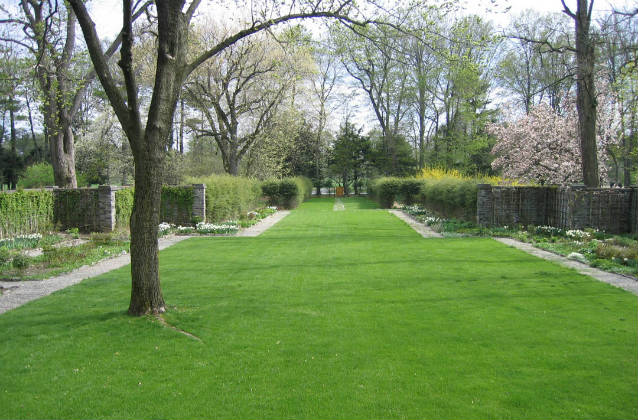In 1885, New York State Senator Thomas Newbold acquired the property at Bellefield. During his ownership, the main house was remodeled in the Colonial Revival style, a number of buildings and features were added, and formal walled garden was designed by landscape gardener Beatrix Farrand. Most of these construction changes were completed by 1917, and the overall landscape still appears much as it did during that time.
"There is no part of the Union where the taste in Landscape Gardening is so far advanced, as on the middle portion of the Hudson." Andrew Jackson Downing, in "A Treatise on the Theory and Practice of Landscape Gardening," 1841

NPS
The Bellefield estate is set along the eastern bank of the Hudson River in Hyde Park, New York and is adjacent to and north of the Roosevelt home known as Springwood. Bellefield became part of the Home of Franklin Roosevelt National Historic Site in 1975 when its owner, Gerald Morgan, donated a portion of the Bellefield estate to the National Park Service. The park preserves 75 acres of the former Bellefield estate, which is among the oldest extant eighteenth century estates in the region. Just to the north, Scenic Hudson protects an additional 86-acre parcel of the former Bellefield estate, which helps to preserve the open rural setting.

NPS
The Bellefield property is historically significant in the area of architecture for the oldest portion of the home that dates to 1795, and for the Colonial Revival renovation work of McKim, Mead & White that was carried out from 1909 to 1911. It is also associated with the era from 1890 to World War I when Dutchess County was the country home of many prominent industrialists, financiers, and politicians. The property is significant in the area of landscape architecture for the walled garden designed by landscape gardener Beatrix Farrand, added in 1911.
In 1795, Judge John Johnston purchased a 175-acre parcel of “Water Lot Six” and built a federal-style home, which is the core of the existing house. He purchased over 300 acres of additional land to create a large estate, built a barn and garage, constructed a stone wall along the Albany Post Road, and named the property Bellefield. Rail lines extended past the property by 1850, which enabled faster transportation to New York City. The property passed through multiple owners until 1885, when Thomas Newbold, a state senator, and his wife Sarah Coolidge, a descendent of Thomas Jefferson and the daughter of Hon. Thomas Jefferson Coolidge, purchased a twenty acre parcel that included the house.

NPS
The Newbolds occupied the Bellefield house and maintained a close relationship with their neighbors to the south, the Roosevelts. The Newbolds carried out major improvements to property in the early 1900s. These included renovation and expansion of the Bellefield house and construction of a large garage according to Colonial Revival designs of architects McKim, Mead & White. They also added a stone house, pump house, water tower, and temporary structures, such as a children’s playhouse. The Newbolds hired landscape gardener Beatrix Jones, later known as Beatrix Farrand, to design a walled garden.

NPS
Mary Newbold Morgan, who married Gerald Morgan Sr., inherited the Bellefield property from her father in 1929, and lived there with her family during the spring and fall months. The Morgans maintained the gardens and house, purchased additional land from Rogers and Roosevelt estates to the north and west. Gerald Morgan Jr. inherited the property in 1969 and subsequently donated the land to the National Park Service between 1973 and 1975, including the 23-acre estate core tract and 52-acre Rodgers Land tract. In 1975 the National Park Service incorporated the property into the Home of Franklin D. Roosevelt National Historic Site and moved the administrative offices and park maintenance facilities into the Bellefield house and service buildings.

NPS
In the late 1990s, the need for an expanded visitor center gained traction. In 1999, the National Park Service transferred one acre at the southwestern boundary to the National Archives and Record Administration for the construction of what would become the Henry A. Wallace Visitor and Education Center. The new facility, entry road, and adjacent parking area were completed in 2003 and opened to the public that year. The center provides visitor orientation and programs for the historic properties managed by the National Park Service and the Franklin D. Roosevelt Presidential Library and Museum managed by the National Archives.
Today, Bellefield preserves the core of a country estate that reflects architectural and landscape design of the early twentieth century. The grounds include the Federal and Colonial Revival house, U-shaped main entry drive, east lawns dotted with mature shade trees and shrubs, a walled garden filled with perennials and vines, service related buildings and structures, pedestrian walks, and a cemetery. Hidden from the Albany Post Road, the Wallace Center and visitor parking area stand behind the Bellefield house. To the northwest of the house, the park preserves a service area with several historic outbuildings and structures, as well as orchard and garden remnants. The garden is open to visitors, and the Hyde Park Trail extends across the property.
Quick Facts
- Cultural Landscape Type: Historic Site
- National Register Significance Level: State
- National Register Significance Criteria: A, C
- Period of Significance: 1885-1917
Landscape Links
Last updated: January 21, 2020
